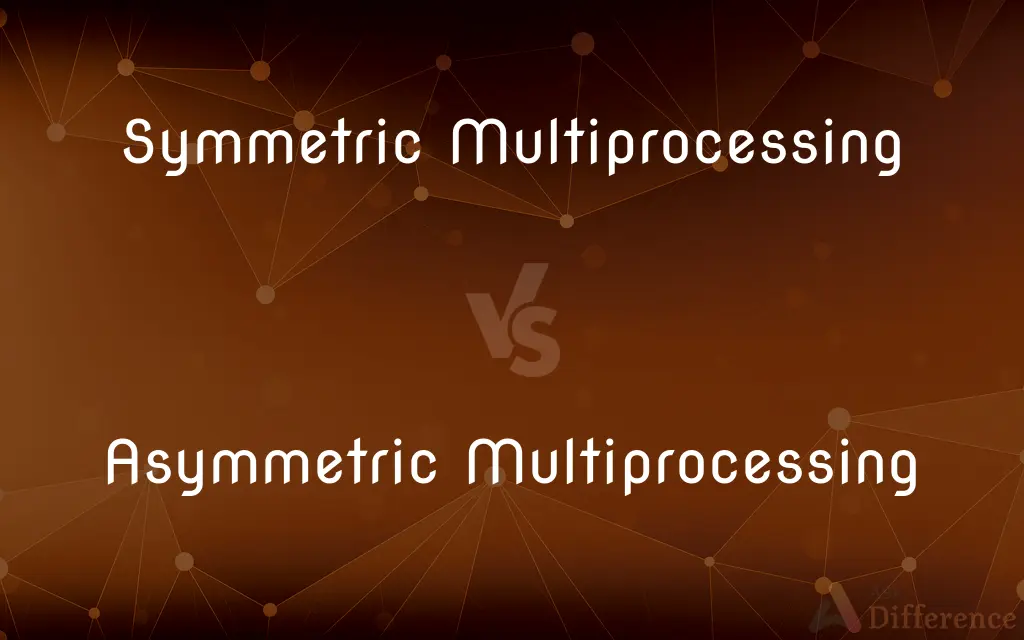Symmetric Multiprocessing vs. Asymmetric Multiprocessing — What's the Difference?
By Tayyaba Rehman — Published on January 3, 2024
Symmetric Multiprocessing (SMP) involves multiple processors sharing tasks equally, while Asymmetric Multiprocessing (AMP) designates specific tasks to specific processors.

Difference Between Symmetric Multiprocessing and Asymmetric Multiprocessing
Table of Contents
ADVERTISEMENT
Key Differences
Processor Role and Task Distribution: In SMP, all processors are equal and can perform any task. In AMP, processors have specific roles or tasks, with a master processor typically managing and assigning tasks to other processors.
Scalability and Performance: SMP systems are scalable and can efficiently handle increasing workloads by adding more processors. AMP systems may not scale as efficiently due to the defined roles of processors and potential bottlenecks.
Complexity and Overhead: SMP can be complex to implement due to the need for processors to coordinate and share resources. AMP is simpler in design but may have higher overhead due to task management by the master processor.
Use Cases: SMP is commonly used in general-purpose computing where tasks are evenly distributed. AMP is often used in embedded systems or applications where specific tasks are assigned to dedicated processors.
System Balance and Load Management: SMP systems balance the load evenly across all processors, while AMP systems can experience imbalances if the master processor becomes a bottleneck.
ADVERTISEMENT
Comparison Chart
Processor Role
All processors are equal
Specific roles for processors
Scalability
Highly scalable
Limited scalability
System Complexity
Complex due to shared resources
Simpler, but with task management overhead
Use Cases
General-purpose computing
Embedded systems, dedicated tasks
Load Distribution
Even distribution of tasks
Potential imbalances in task load
Compare with Definitions
Symmetric Multiprocessing
Scalable for handling increased workloads.
Adding more CPUs enhances the performance of our SMP system.
Asymmetric Multiprocessing
Often includes a master processor for task management.
The master processor in our AMP setup delegates tasks to specialized processors.
Symmetric Multiprocessing
SMP involves multiple processors handling tasks with equal priority.
Our server uses SMP to efficiently manage multiple applications.
Asymmetric Multiprocessing
Common in embedded and real-time systems.
Our real-time control system uses AMP for dedicated task execution.
Symmetric Multiprocessing
Load balancing is inherent in SMP systems.
SMP ensures even workload distribution across all CPUs.
Asymmetric Multiprocessing
AMP assigns specific tasks or roles to each processor.
In our AMP system, one processor handles user requests while another manages database operations.
Symmetric Multiprocessing
All processors have access to the same memory and resources.
In SMP, processors share the same memory pool for data processing.
Asymmetric Multiprocessing
Can be less complex but may have bottlenecks.
AMP's simplicity is advantageous, though the master processor can become a bottleneck.
Symmetric Multiprocessing
Common in multi-core and multi-processor computer systems.
Modern multi-core systems typically use SMP for parallel processing.
Asymmetric Multiprocessing
Used in systems where dedicated processing is required.
AMP is ideal for our embedded system that requires dedicated signal processing.
Common Curiosities
What is Symmetric Multiprocessing (SMP)?
SMP is a system where multiple processors share tasks and resources equally.
Can SMP systems handle multiple tasks simultaneously?
Yes, SMP systems are designed to handle multiple tasks concurrently.
How do SMP and AMP differ in scalability?
SMP systems are more scalable as adding more processors increases overall performance, whereas AMP scalability is limited by specific processor roles.
Can you convert an SMP system to an AMP system?
Converting an SMP system to an AMP system would require significant architectural changes.
What is Asymmetric Multiprocessing (AMP)?
AMP is a system where each processor has specific tasks or roles, often managed by a master processor.
Are multi-core processors an example of SMP?
Yes, multi-core processors where each core can perform any task are examples of SMP.
Does AMP offer better real-time performance?
AMP can offer better real-time performance for specific tasks due to dedicated processing.
Can AMP systems be used in high-performance computing?
AMP systems are generally not favored in high-performance computing due to limited scalability.
Is AMP suitable for general-purpose computing?
AMP is less common in general-purpose computing and more suited to specialized or embedded systems.
Why is AMP used in embedded systems?
AMP is used in embedded systems for dedicated processing tasks and simpler design.
Can SMP lead to resource contention issues?
Yes, resource sharing in SMP can lead to contention issues, requiring efficient management.
How does task management work in SMP systems?
In SMP systems, an operating system or scheduler evenly distributes tasks among all processors.
Is AMP easier to implement than SMP?
AMP can be simpler to implement due to less complex resource sharing and management.
What type of applications benefit most from SMP?
Applications that require parallel processing and can distribute tasks evenly benefit from SMP.
Do SMP systems require special software support?
Yes, SMP systems require an operating system capable of managing multiple processors effectively.
Share Your Discovery

Previous Comparison
JSP vs. JSF
Next Comparison
Aerobic Respiration vs. Anaerobic RespirationAuthor Spotlight
Written by
Tayyaba RehmanTayyaba Rehman is a distinguished writer, currently serving as a primary contributor to askdifference.com. As a researcher in semantics and etymology, Tayyaba's passion for the complexity of languages and their distinctions has found a perfect home on the platform. Tayyaba delves into the intricacies of language, distinguishing between commonly confused words and phrases, thereby providing clarity for readers worldwide.










































